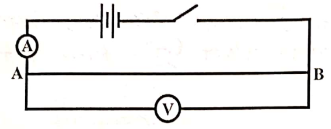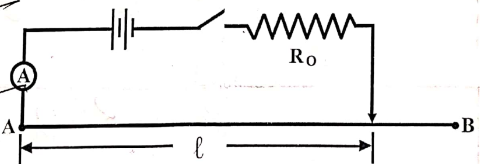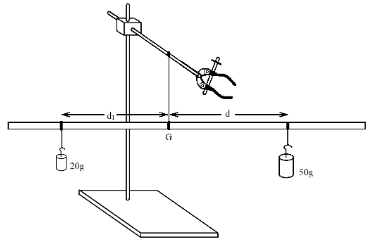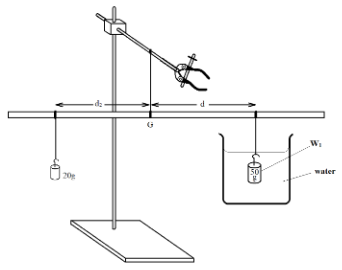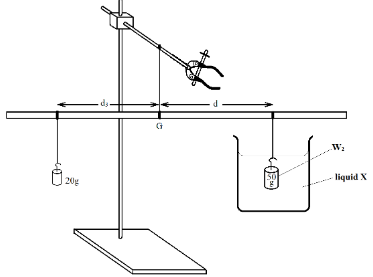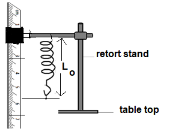Instructions to Candidates
- Answer ALL the questions in the spaces provided in the question paper
- You are supposed to spend the first 15 minutes of the 2 ½ hours allowed for this paper reading the whole paper carefully before commencing your work.
- Marks are given for a clear record of the observations actually made.
- Non-programmable silent electronic calculators and KNEC Mathematical tables may be used except where stated otherwise.
QUESTION 1
You are provided with the following: -
- a resistor labelled Ro
- a mounted wire AB of kength 100cm, (nichrome SWG 32)
- an ammeter 0-1A,
- a voltmeter 0 - 5V,
- a switch
- six connecting wires,
- two new dry cells,
- a cell holder
Proceed as follows:
-
- Set the circuit shown in the figure 1.
Figure 1 - With the switch closed, measure and record the current thorugh the wire AB and the voltage across it.
I = ......................................... A (1 mark)
V = ........................................ V (1 mark) - Determine the T resistance per centimetre. (2 marks)
- Set the circuit shown in the figure 1.
-
- Set up the apparatus as shown in figure 2
- Clip the wire Ab at the length L = 15cm and close the switch. Read and record the Current 1 in table 1
- .Clip the wire AB at other lengths, L shown in the table 1. Read and record the currents 1 in table 1.
- Complete table 1 by determining the values of 1/I and resistance R (5 marks)
Table 1Length, L (cm) 15 30 45 60 75 90 Current, I (A) 1/I (A−1) Resistance R = T × L(Ω)
- Set up the apparatus as shown in figure 2
-
- On the grid provided, plot a graph of 1/I (A−1) against resistance, R(Ω) (5 marks)
QUESTION 2
PART A
You are provided with the following apparatus:
- Metre rule
- Thread
- A complete retort stand
- Two masses, a 50g and 20g mass
- Water in a beaker
- Liquid X in a beaker
- Suspend the metre rule so that it balances at its centre of gravity G. Read and record the value of G.…………………………………………………………………… (1 mark)
- Suspend the 50g mass at a distance d=10cm, then suspend the 20g mass and adjust its position such that the metre rule is balanced as shown in the figure 2
Figure 2 - Record the distance distance d1
d1…………………………………………………. cm (1 mark) - While maintaining the distance d , immerse the the 50g mass completely in water, as shown in the figure 3.
Figure 3 - Adjust the position of the 20g mass to balance the metre rule again. Record the new distance d2
d2………………………………………………………….. cm (1 mark) - Using the results obtained above, calculate the value of W1, weight of the 50g mass in water. (2 marks)
- Determine the upthrust U1 on the 50g mass in water. (2 marks)
- Repeat steps (d), (e) and (f) but now the 50g is totally immersed in liquid X as shown in the figure 4.
Figure 4 - Using the results obtained above, calculate the value of W2, weight of the 50g mass in liquid X. (2 marks)
- Determine the upthrust U2 on the 50g mass in liquid X. (2 marks)
- Given that ρL = U2 × ρw where ρw = 1000kgm−3 . Calculate PL (2 marks)
U1
QUESTION 3
PART B
You are provided with the following apparatus:-
- A metre rule.
- Stop watch.
- Stand, clamp and boss.
- Spring.
- Two pieces of wood.
- A beam balance or electronic balance (to be shared)
- Mass labelled M.
Proceed as follows:Hang the spring vertically by clamping one end as shown in figure 5.
Figure 5- Measure the length, Lo of the unloaded spring, and record below.
Lo = ……………………………………………… cm (1 mark) - Hang the mass M given from the lower end of the spring. Measure the length, of the loaded spring.
L1 = ………………………………….. cm (1 mark) - Find the value of
L = L1 − L0 = ……………………………………..cm (1 mark) - Using the beam balance, determine the mass, M of the object.
M = …………………………………………kg (1 mark) - Hang the mass M from the lower end of the spring. Displace it by a small vertical distance and release so that the spring makes vertical oscillations. Measure and record, time for the number of oscillations given in the table 2.
- Complete table 2. (3 marks)
Oscillations, N 10 Time in seconds, t (s) Q = (N + 10t)s
10
MARKING SCHEME
QUESTION 1
You are provided with the following: -
- a resistor labelled Ro
- a mounted wire AB of kength 100cm, (nichrome SWG 32)
- an ammeter 0-1A,
- a voltmeter 0 - 5V,
- a switch
- six connecting wires,
- two new dry cells,
- a cell holder
Proceed as follows:
-
- Set the circuit shown in the figure 1.
Figure 1 - With the switch closed, measure and record the current thorugh the wire AB and the voltage across it.
I = .........0.12 − 0.24 2dp (closed range) ✓1 ................................ A (1 mark)
V = .......2.0 − 2.6 1dp (closed range) ✓1 ................................. V (1 mark) - Determine the T resistance per centimetre. (2 marks)
R = V/l = 2.6 ÷ 100cm
0.24/cm
T = 0.1083Ω
- Set the circuit shown in the figure 1.
-
- Set up the apparatus as shown in figure 2
- Clip the wire Ab at the length L = 15cm and close the switch. Read and record the Current 1 in table 1
- .Clip the wire AB at other lengths, L shown in the table 1. Read and record the currents 1 in table 1.
- Complete table 1 by determining the values of 1/I and resistance R (5 marks)
Table 1Length, L (cm) 15 30 45 60 75 90 Current, I (A) 0.30 0.28 0.26 0.24 0.22 0.20 1/I (A−1) 3.333 3.571 3.846 4.167 4.545 5 Resistance R = T × L(Ω) 1.6245 3.249 4.874 6.498 8.123 9.747
- Set up the apparatus as shown in figure 2
-
- On the grid provided, plot a graph of 1/I (A−1) against resistance, R(Ω) (5 marks)
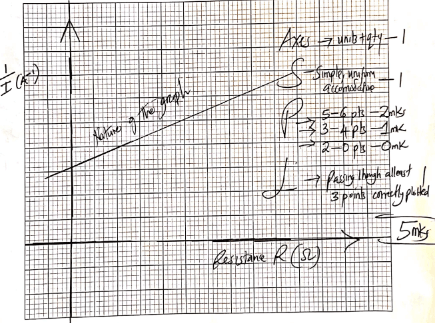
- On the grid provided, plot a graph of 1/I (A−1) against resistance, R(Ω) (5 marks)
QUESTION 2
PART A
You are provided with the following apparatus:
- Metre rule
- Thread
- A complete retort stand
- Two masses, a 50g and 20g mass
- Water in a beaker
- Liquid X in a beaker
- Suspend the metre rule so that it balances at its centre of gravity G. Read and record the value of
G.……………50 ± 1.0cm 1d.p a must……………………………………………………… (1 mark) - Suspend the 50g mass at a distance d=10cm, then suspend the 20g mass and adjust its position such that the metre rule is balanced as shown in the figure 2
Figure 2 - Record the distance distance d1
d1…………25.0 ± 1.0 1dp a must………………………………. cm (1 mark) - While maintaining the distance d , immerse the the 50g mass completely in water, as shown in the figure 3.
Figure 3 - Adjust the position of the 20g mass to balance the metre rule again. Record the new distance d2
d2………19.0 ± 1.0 1 dp a must……………………………….. cm (1 mark) - Using the results obtained above, calculate the value of W1, weight of the 50g mass in water. (2 marks)
W1d = Wd2
W1 × 10cm = 0.2N × 19.0cm Correct substitution in the principle of moments
W1 = 0.38N ✓1 Correct answer 4sgf or exact * (ignore units) - Determine the upthrust U1 on the 50g mass in water. (2 marks)
U1 = 50 × 10 − 0.38 ✓½ Correct substitution
1000
0. 5 − 0.38 ✓½ Correct evaluation
U1 = 0.12N ✓1 Correct answer 4sgf or exact *(ignore units) - Repeat steps (d), (e) and (f) but now the 50g is totally immersed in liquid X as shown in the figure 4.
Figure 4 - Using the results obtained above, calculate the value of W2, weight of the 50g mass in liquid X. (2 marks)
d3 = 21.0cm ± 1.0cm
W2 × 0.0m = 0.2N × 0.21m Correct substituion in principle of moments
W2 = 0.42N ✓1 Correct answer 4sgfor exact *Ignore units - Determine the upthrust U2 on the 50g mass in liquid X. (2 marks)
U2 = 50 × 10 − 0.42 ✓ ½ correct substitution
1000 ✓ ½ correct evaluation
= 0.08N ✓ 1 correct answer (4sgf or exact) * Ignore units) - Given that ρL = U2 × ρw where ρw = 1000kgm−3 . Calculate PL (2 marks)
U1
ρL = 0.08N × 1000 ✓ ½ correct substitution
0.12N ✓ ½ correct evaluation
666.67 kg/m3 ✓1 correct answer with correct unit (4sgf or exact)
Missing unit - deny ½
Wrong unit- penalize fully.
- Suspend the metre rule so that it balances at its centre of gravity G. Read and record the value of
QUESTION 3
PART B
You are provided with the following apparatus:-
- A metre rule.
- Stop watch.
- Stand, clamp and boss.
- Spring.
- Two pieces of wood.
- A beam balance or electronic balance (to be shared)
- Mass labelled M.
Proceed as follows:
-
Hang the spring vertically by clamping one end as shown in figure 5.
Figure 5 - Measure the length, Lo of the unloaded spring, and record below.
Lo = …………15.0 (students value, 1dp a must)…………………………………… cm (1 mark) - Hang the mass M given from the lower end of the spring. Measure the length, of the loaded spring.
L1 = …………36.0 (Students value, 1dp a must ……………………….. cm (1 mark) - Find the value of
L = L1 − L0 = …36.0 − 15.0 = 21.0 (Correct substraction of students value)…………………………………..cm (1 mark) - Using the beam balance, determine the mass, M of the object.
M = ……0.08 − 0.11 (closed range) correct evaluation of students value……………………………………kg (1 mark) - Hang the mass M from the lower end of the spring. Displace it by a small vertical distance and release so that the spring makes vertical oscillations. Measure and record, time for the number of oscillations given in the table 2.
- Complete table 2. (3 marks)
2dp a must closed range ✓1Oscillations, N 10 Time in seconds, t (s) (8.00 − 12.00s) Q = (N + 10t)s
10(8.00 + 10 × 8.00)
10
= 8.8
* working must be shown
*Correct substitution ✓½
* Correct evaluation ✓½
* Correct answer to 4sgf or exact ✓1 Ignore unit
Download Physics Paper 3 Questions and Answers - Maranda High School Mock Exams 2023.
Tap Here to Download for 50/-
Get on WhatsApp for 50/-
Why download?
- ✔ To read offline at any time.
- ✔ To Print at your convenience
- ✔ Share Easily with Friends / Students

